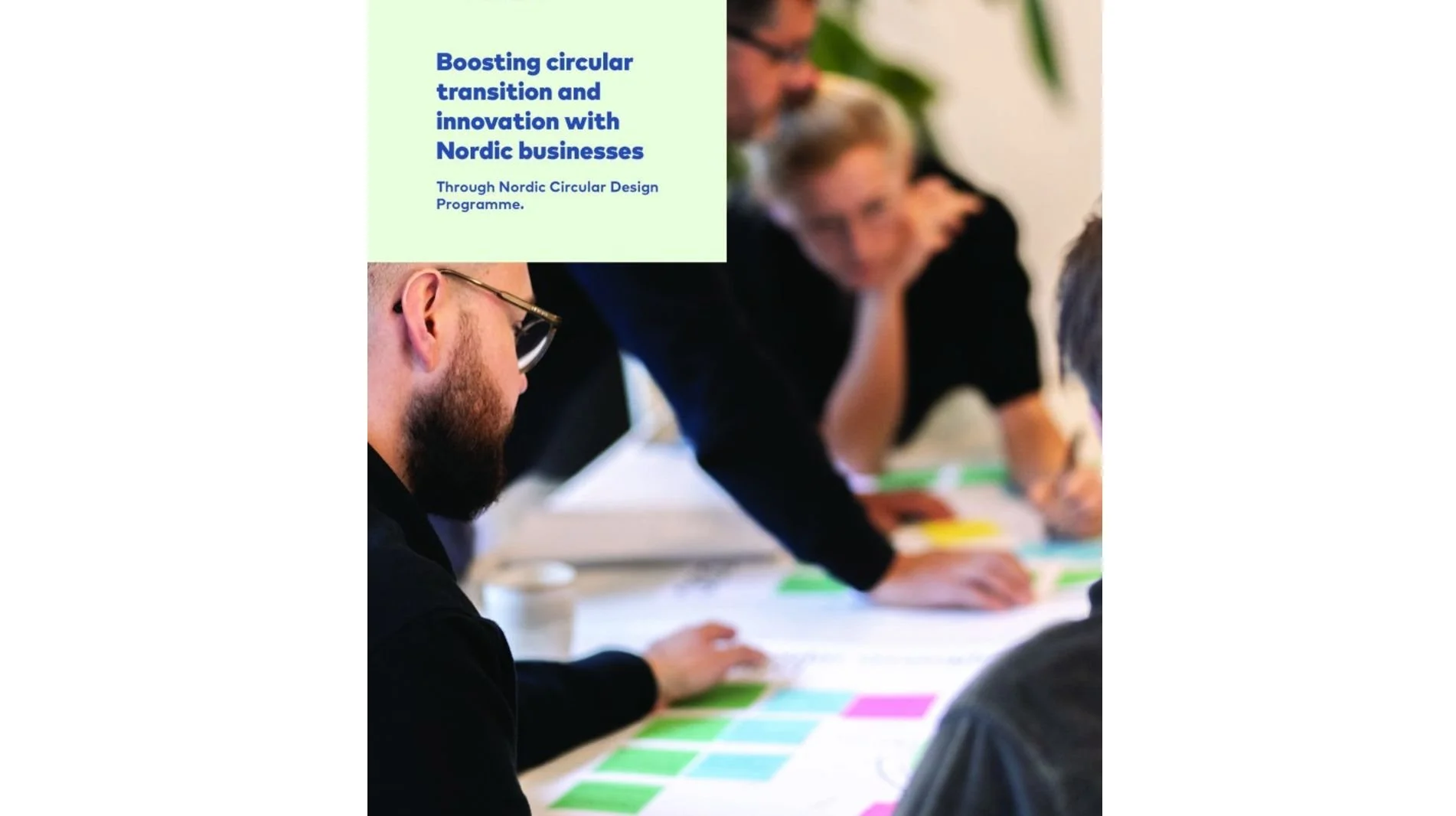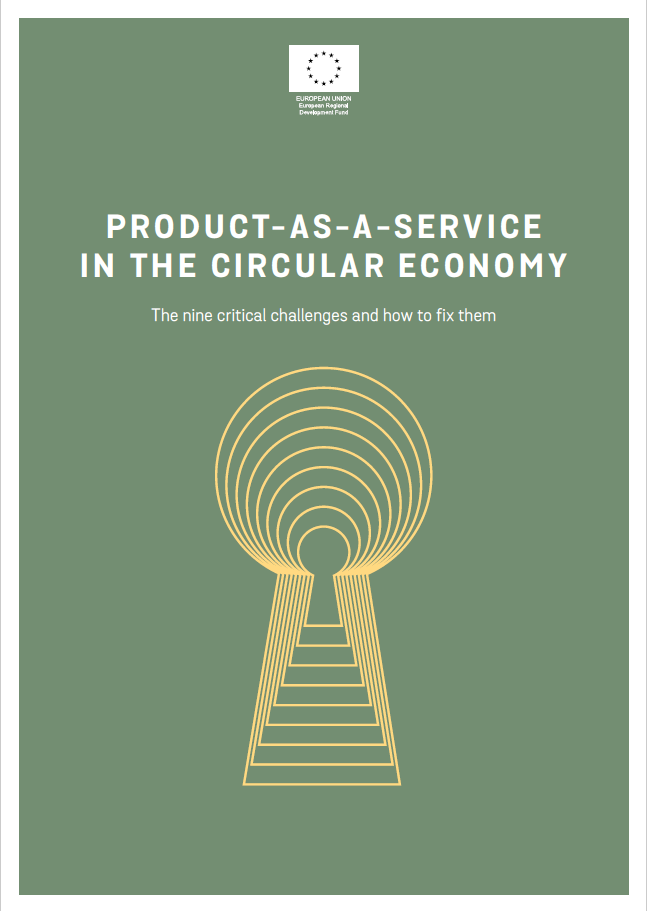The Visionary CEO’s Guide to Sustainability 2025
More than 70% of manufacturing executives believe that circular business solutions will boost their revenue by 2027, a recent survey shows.
Some 65% of businesses expect circular solutions to improve their resilience.
High upfront investments and ongoing costs remain a hurdle to embracing circular business models.
Boosting circular transition and innovation with Nordic businesses
Denna rapport är särskilt relevant för företag som förbereder sig för EU:s kommande ekodesignförordning och för beslutsfattare, såsom myndigheter, icke-statliga organisationer och branschorganisationer, som vill stödja den privata sektorn i övergången till en cirkulär ekonomi.
Rapporten bygger på lärdomarna frånNordic Circular Design Programme (NCDP). Det första programmet för cirkulär design ägde rum mellan oktober 2024 och maj 2025 och omfattade Danmark, Finland, Sverige och Norge. Programmet leddes av Ethica (FI) i samarbete med tre nationella partners: Dansk Designcenter (DK), Cradlenet (SE) och Norskt center for cirkulär ekonomi (NO).
Svenskt Näringsliv: Towards a Competitive and Circular Europe
Europe’s transition to a circular economy must go hand in hand with industrial competitiveness, innovation and open markets. This paper holds 14 recommendations from the Swedish business community on how to make the circular economy work better for companies, large and small, while strengthening Europe’s resilience and environmental performance. These should be considered by the European Commission when developing the upcoming Circular Economy Act, but also in a wider policy context.
A Planetary Boundary for Mineral, Metal, and Fossil Resource Extraction Rates
Resource consumption is set to rise in coming decades. A circular economy can reduce environmental impacts by cutting raw material use and emissions but will still require some primary resources due to growth, stock expansion, and dissipation. The planetary boundary framework could help set limits, yet it currently lacks boundaries for minerals, metals, and fossil resources. This study proposes a principle for such a boundary, based on net accessibility and fair resource allocation across generations, to define a sustainable extraction rate for a circular economy. Further work is needed to operationalize this approach.
Circularity Gap Report Norway
Norges ekonomi är endast 2,4 % cirkulär, enligt Circularity Gap Report Norway 2025 från Circular Norway och Circle Economy. Hög resursförbrukning och stor importandel bromsar utvecklingen. Rapporten lyfter fram sex åtgärder som kan öka cirkulariteten till 45,8 % och kraftigt minska materialanvändning och utsläpp.
Circular Economy Outlook Nordics 2024
Rapporten Circular Economy Outlook Nordics undersöker i vilken utsträckning de 809 börsnoterade företagen (LargeCap, MidCap, SmallCap) i Danmark, Finland, Norge och Sverige har införlivat cirkularitet i sin affärsstrategi och sin verksamhet. Denna banbrytande studie är den första i sitt slag för regionen.
Publicerad: 2024-12-04
Circular Economy Outlook 2024 Sverige
Svenska börsnoterade företag intensifierar arbetet med cirkulär ekonomi. Affärsmöjligheter och minskad klimatpåverkan är de starkaste drivkrafterna för börsbolagens cirkulära omställning. Det framgår i rapporten Circular Economy Outlook 2024 för Sverige som är Cradlenets flaggskeppsrapport och som tas fram i samarbete med RISE.
Publicerad: 2024-06-13
Circular Action Guide 2024
Författare: Cradlenet och Exponential Roadmap Initiative
This guide is for managers and employees in eg business development, product design and management, procurement, and sustainability roles. It offers practical steps for companies to analyse their value chain, product portfolio and business model in order to scale circular climate solutions and fully integrate circularity into their strategic business functions.
Publicerad: 2024
Cirkulära dialogträffar
RE:Source har med hjälp av Cradlenet, Circle Economy och Deloitte samlat några av de sektorer som har störst potential att öka den nationella cirkulariteten i fyra rundabordssamtal. Dessa resulterade i ett antal innovationsinsatser som kan bidra till utveckling av en ekonomi med hög resurseffektivitet och låg resursförbrukning. Läs om de intressanta resultaten i rapporten nedan.
Regenerate the Economic Machine
Författare: Christopher Lyrhem, Future & Strategy Analyst at SEB
Regenerate the Economic Machine is an explorative what-if analysis, containing five parts and 30 episodes, discussing how moving from depletive to regenerative inputs into our global economy could transform the current norms in manufacturing, economics, business, finance, and consumption. The usership business model could potentially become the spark for this.
Publicerad: 2024
Hur kan pantsystemen utvecklas för plastförpackningar?
Genom att utvärdera tre olika scenarier för hur pantsystemet för plast skulle kunna utvecklas, visar rapporten de viktigaste effekterna detta skulle ha utifrån fem olika perspektiv: miljö, ekonomi, socialt, teknik och politik.
Rapporten visar bland annat att återanvändning är bättre än återvinning ur ett miljöperspektiv och att det kan vara ekonomiskt lönsamt. Men det krävs styrmedel och teknisk utveckling för att pantsystemen ska kunna införas.
Nordic Circular Economy: A Pathway to Sustainable Growth and Resilience
Today, 6% of the Nordic region’s economy is circular—meaning that ~6% of resources used for production come from recovered materials. By comparison, the EU average is at ~12% circularity, with an ambition to double the rate by 2030. Reaching this ambition in the Nordics could unlock an annual ~€48 billion economic opportunity by 2030, similar to 3% of the Nordic region’s GDP in 2021.
Publicerad: 2023-08-27 av Boston Consulting Group
Nollvision avfall för en hållbar konsumtion och produktion
Nationell samordnare för Agenda 2030 har tagit fram denna rapport med bedömningen att vi behöver grundläggande förändringar i vårt sätt att förstå och hantera komplexa samhällsutmaningar. Samordnaren har tillsammans med andra utforskat och lärt av nollvisionsarbetet inom trafiksäkerheten och lyfter nollvisionen för avfall som ett sätt att utveckla styrning och ledning för att hantera komplexa samhällsproblem.
Ecocide Law for an Economy within Planetary Boundaries
Författare: Jonas Roupé, End Ecocide
Publicerad: Januari 2023
Vår ekonomiska modell undergräver och hotar ekonomin. Det är lika sant som paradoxalt. Nya rapporten Ecocide law for an Economy within Planetary Boundaries ger en detaljerad analys av hur en lag mot storskalig miljöförstöring bidrar till en hållbar utveckling och en mer cirkulär och regenerativ ekonomi.
Circular City Transformation
Producerad av: Sweco
Publicerad: oktober 2022
Våra städer står i centrum när det är dags att ställa om. Genom att utnyttja sina egenskaper som innovationsnav och finansiella centra kan de hitta nya vägar framåt att skapa värde av det som tidigare setts som avfall.
Beräkningar som Swecos experter gjort visar att en omställning till cirkulär ekonomi kan innebära att städerna minskar sitt energibehov med 75% samtidigt som koldioxidutsläppen minskar med 97% jämfört med idag.
Product-as-a-Service in the circular economy
Producerad av: Cradlenet & Stena Circular Consulting
Publicerad: 2022-09-22
Cradlenet har tillsammans med Stena Circular Consulting tagit fram rapporten ”Product-as-a-Service in the circular economy: the nine critical challenges and how to fix them", där vi har vi identifierat de mest kritiska utmaningarna företag står inför vid en omställning till tjänstebaserade affärsmodeller (Product-as-a-Service, eller PaaS) och en metod för hur man kan lyckas med sin omställning.
Scaling sufficiency: towards less material consumption
Med utgångspunkt i litteratur kring hållbar konsumtion, politik och styrmedel för tillräcklighet, samt hur hållbarhetsinitiativ kan få större genomslag, eller ”skalas”, har denna avhandling som syfte att bidra till ökad kunskap om social och ekologisk omställning, med specifikt fokus på(o)hållbar konsumtion. Sverige utgör den geografiska kontexten med dess, åena sidan, starka engagemang i hållbar utveckling från civilsamhälle, företagoch offentlig sektor och, å andra sidan, ohållbara konsumtion av resurser percapita.
Circularity Gap Report: Sweden
Producerad av: Circle Economy, Re:Source, RISE
Publicerad: april 2022
Sweden's emissions reduction goals are the most ambitious worldwide: net-zero by 2045. But the energy transition is only part of the story. Our Circularity Gap Report Sweden finds that Sweden, being only 3,4% circular, must—and can—do more to become a true climate champion. The key lies in building its circular economy to shrink its large material footprint.
62 sätt att möjliggöra hållbar konsumtion
Rapporten presenterar 62 möjliga lösningar för att skapa en mer hållbar konsumtion. Det handlar om alltifrån att sätta krav på prylars på reparerbarhet, införa flygrätter, till att beskatta ohållbar mat. Rapporten ska fungera som inspiration och verktygslåda för politiker, civilsamhälle och beslutsfattare som vill styra mot hållbar konsumtion.
Styrmedel för cirkulär omställning av små- och medelstora företag
I december överlämnade expertgruppen för små och medelstora företag, som leddes av Cradlenet, sin slutrapport till Delegationen för cirkulär ekonomi. Rapporten ger 32 förslag på styrmedel som underlättar för små och medelstora företag att ställa om till cirkulär ekonomi.




















